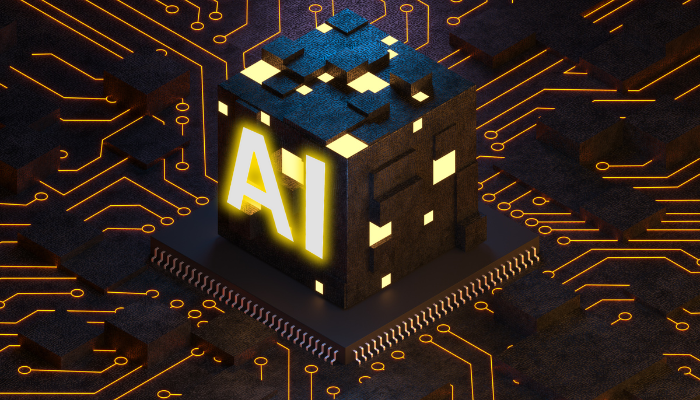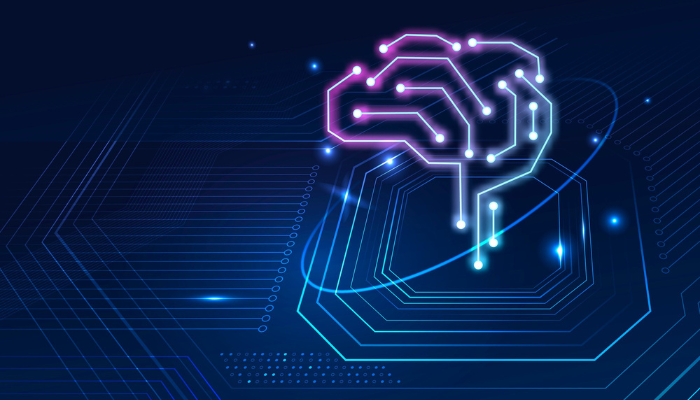“The advance of technology is based on making it fit in so that you don’t really even notice it, so it’s part of everyday life.”
– Bill Gates
Artificial Intelligence is everywhere—helping you shop online, giving directions, or even recommending movies. But have you ever stopped to think about what makes it all work? There’s a whole tech stack behind it, kind of like a layered cake.
At the bottom of the AI tech stack, you have data—the raw material every AI needs to learn. Next are algorithms, the math that processes and makes sense of all that data. Frameworks sit above, simplifying the development process for you. Finally, the applications bring it all together—the parts you interact with, like your phone’s voice assistant or a self-driving car.
Here’s a fact to put things into perspective: the global AI market is set to grow at a staggering 36.6% annually, reaching $1,811.75 billion by 2030. That’s how fast AI is becoming indispensable in every field.
In this blog, we’ll help you understand the AI technology stack. You’ll learn about the tools, techniques, and trends shaping the future of AI—and how you can keep up.
Understanding the AI Technology Stack: What Sets It Apart?
An AI technology stack is the backbone of modern artificial intelligence systems, combining multiple layers to enable intelligent decision-making. To truly understand the AI technology stack, think of it as a carefully structured framework that powers AI applications—from voice assistants to predictive analytics.
The AI technology stack refers to a multi-layered architecture, comprising data, algorithms, frameworks, and applications, each playing a critical role in building AI solutions.
Purpose of the AI Technology Stack
The AI technology stack makes building and scaling AI systems easier and faster. It’s like a toolkit that brings everything—data, models, and applications—together to work seamlessly.
Let’s break it down for you:
1. Integration
The stack connects all the moving parts, so your data flows smoothly into models, and those models power real-world applications. It cuts the complexity for you.
2. Scalability
Got more data coming in as your business grows? The stack can handle it without breaking a sweat, adapting to bigger workloads effortlessly.
3. Adaptability
Unlike older systems, this stack evolves on its own. It learns from fresh data and keeps improving, so you’re always ahead.
4. Efficiency
Why waste time on repetitive tasks? The stack takes care of things like cleaning data or fine-tuning models, so you can focus on more impactful work.
5. Driving Innovation
With ready-made tools and frameworks, the stack helps you try out new ideas quickly. It lowers the barrier so you can move from concept to execution faster.
How Does It Compare to a Traditional Tech Stack?
AI tech stacks are designed to handle complexities beyond traditional tech stacks. Here’s how they differ:
| Aspect | Traditional Tech Stack | AI Technology Stack |
| Focus | Static systems with fixed inputs and outputs. | Adaptive systems that learn and evolve. |
| Data Processing | Predefined, rule-based. | Continuous learning with vast datasets. |
| Tools | Standard coding frameworks. | AI-specific frameworks like TensorFlow or PyTorch. |
| Flexibility | Limited adaptability. | Highly scalable and flexible. |
| Core Components | Servers, databases, and basic software tools. | Data pipelines, ML models, and advanced frameworks. |
| Use Cases | Transaction processing, reporting, web apps. | Predictive analytics, NLP, and intelligent automation. |
To understand the AI technology stack, you need to see how each layer contributes uniquely to creating smarter, more adaptive systems.
Layers of the AI Technology Stack: Building Smarter Systems
To truly understand the AI technology stack, it helps to break it down into its individual layers. Each one plays a unique role, working together to create the magic behind AI systems.
Let’s take a closer look at these layers to see how they make businesses smarter, more agile, and future-ready.
1. Data Layer: The Bedrock of AI
Everything in AI starts with data—raw, messy, and often unorganized. This is where the journey begins. The data layer in the AI software stack is responsible for collecting, storing, and cleaning the data so it’s ready for use.
- What it does: It gathers data from various sources such as customer behavior logs, IoT sensors, or even social media posts.
- Why it matters: High-quality data is the foundation of all AI systems. In fact, Gartner found that poor data quality costs businesses a shocking $12.9 million annually.
- Example: Imagine an e-commerce website using customer purchase histories to recommend personalized products. This not only boosts engagement but also drives higher sales because it’s tailored to the user’s preferences.
2. Algorithm Layer: The Problem-Solver
Once the data is ready, the algorithm layer comes into play. To understand the AI technology stack, think of this layer as the “brain” of the AI system—it processes the data, makes sense of it, and drives decisions based on its findings.
- What it does: It transforms raw data into insights through powerful tools like machine learning models, neural networks, or decision trees.
- Why it matters: Algorithms are what make AI smart. They help solve complex problems far quicker than humans can. For instance, OpenAI‘s models (like GPT-4) process billions of data points to generate highly accurate responses.
- Example: To better understand the AI technology stack, consider how banks use algorithms to spot fraudulent transactions in real-time. They monitor spending patterns and flag anything that seems off, helping prevent fraud before it happens.
3. Framework Layer: The Developer’s Toolbox
Building AI from scratch is no small feat. That’s where frameworks come in—they simplify the process by providing pre-built, ready-to-use tools. These frameworks are essential for understanding the AI technology stack, as they make development faster, easier, and more efficient.
- What it does: Frameworks offer libraries and modules to simplify complex tasks. For example, TensorFlow helps with deep learning, and Scikit–learn assists with data analysis.
- Why it matters: With frameworks, developers don’t have to reinvent the wheel. They can use powerful, pre-built tools to focus on creating innovative solutions instead of writing basic code.
- Example: A healthcare provider might use PyTorch (a popular deep learning framework) to develop AI models that analyze medical images and detect early signs of disease. This makes the process of diagnosing much faster and more accurate.
4. Application Layer: The End-User Interface
Finally, we reach the application layer. In understanding the AI technology stack, this is where everything comes together and transforms into something users can interact with. Whether it’s a virtual assistant, a chatbot, or a recommendation engine, this layer brings AI to life.
- What it does: It translates the AI’s power into something practical by delivering it through apps or APIs that users can actually interact with.
- Why it matters: Without this layer, AI would just be a bunch of code. It’s the application layer that makes AI accessible and actionable for users, allowing businesses to implement AI into real-world solutions.
- Example: Think about a smart home system that adjusts your thermostat and lights based on your daily routines. It makes your life easier and more energy-efficient by learning your preferences over time.
Every layer builds on data—let’s see how it shapes the backbone of AI systems.
Data in the AI Tech Stack: Laying the Foundation
Data is at the heart of every AI system, forming the foundation of any AI stack. Without it, AI is just an idea. It’s like fuel for an engine—without it, nothing works.
Types of Data: Structured, Unstructured, and Semi-Structured
To understand how data works in AI, it’s important to know the types of data you’re dealing with. Here’s a breakdown of each one:
1. Structured Data
Think of this as the neat, organized data—like rows and columns in a spreadsheet or a database table. Understanding this structure is crucial to understand the AI technology stack, as it allows data to be easily read and processed in specific formats like numbers, dates, and strings.
Example: Customer names, phone numbers, and transaction amounts are all examples of structured data. It’s easy to sort, analyze, and process.
2. Unstructured Data
This is the messy data that doesn’t fit into a neat table. It’s all over the place and can come in various formats—like text, images, or videos. Unstructured data is harder to process and analyze because there’s no specific format.
Example: A collection of social media posts, customer reviews, or video files are unstructured data. It’s a goldmine for AI but requires more work to analyze.
3. Semi-Structured Data
This is a mix of both structured and unstructured data. It doesn’t fully follow the traditional table format but has some degree of organization. Gaining clarity on this type of data is key to understanding the AI technology stack, as it bridges the gap between rigidly organized and completely unstructured data formats.
Example: Emails or XML files are semi-structured. They have some tags or labels to separate data but aren’t as neatly organized as structured data.
Before AI can use data, it needs to be prepared.
Data Preprocessing: Cleansing, Transformation, and Augmentation
You might be wondering why data preprocessing is such a big deal in AI. The reason is simple: AI systems can only perform as well as the data they are trained on. If the data is messy, incomplete, or inaccurate, the AI will make poor predictions or decisions.
That’s why spending time on cleansing, transforming, and augmenting the data is essential. To truly understand the AI technology stack, you must recognize that high-quality, well-prepared data forms the foundation of an effective AI system. The cleaner the data, the better the results.
1. Cleansing
Cleansing removes inconsistencies, duplicates, and missing values. This ensures the data is accurate and reliable for analysis.
Example: Removing duplicate entries in customer databases helps AI recommend the right products without errors.
2. Transformation
This step converts data into a usable format, such as normalizing numbers or converting text into numerical values for machine learning models.
Example: A finance company transforms transaction logs into formats that its fraud detection algorithms can easily read.
3. Augmentation
This involves enhancing the dataset by adding new information or generating synthetic data.
Example: In image recognition, data augmentation might include flipping or rotating images to teach AI systems to recognize objects in various scenarios.
Here’s the thing: AI doesn’t stay perfect forever. To truly understand the AI technology stack, you must see the importance of regular updates, fine-tuning, and monitoring for models to stay relevant. Without MLOps, you’d spend more time fixing problems than building solutions.
MLOps in AI Tech Stack: Making AI Work in the Real World
When it comes to AI, building a model is just the beginning. Understanding the AI technology stack includes recognizing that the real challenge lies in making that model work consistently in the real world.
That’s where MLOps comes in—a behind-the-scenes system ensuring everything runs smoothly, letting you focus on results instead of worrying about hiccups.
What Exactly Is MLOps and Why Does It Matter?
MLOps, short for Machine Learning Operations, takes the chaos out of deploying AI models. It combines the efficiency of DevOps with the complexities of machine learning, creating a streamlined way to manage the entire AI lifecycle.
Why It’s Important: Training a model in a controlled environment is one thing, but once it’s out in the real world, things can go wrong—data changes, models break, and updates get messy. MLOps helps you avoid these problems by making sure your models stay accurate and reliable over time.
The MLOps market is projected to reach $13.3 billion by 2030, showing how essential it is for businesses to embrace these practices. It’s no longer optional—it’s a game-changer.
Tools That Make MLOps Work for You
There are some incredible tools out there to help you implement MLOps effectively. Here’s a list of six that businesses swear by:
1. MLflow
This tool keeps track of all your experiments, so you don’t lose valuable work. You can also use it to manage deployments.
- How It Helps: Imagine testing five different models and trying to figure out which one performed best. MLflow logs everything, so the decision is easy.
- Example: Retailers use MLflow to track customer segmentation experiments, picking the one that boosts sales the most.
2. DVC (Data Version Control)
DVC is like Git but for your data. It tracks changes in datasets and ML experiments.
- How It Helps: If your data gets updated, DVC lets you go back and compare results from different versions.
- Example: Banks use DVC to track changes in fraud detection data and ensure their models stay effective.
3. Kubeflow
This tool makes it easier to scale your AI models using Kubernetes.
- How It Helps: If you’re working on a big project that needs to run across multiple systems, Kubeflow handles the complexity for you.
- Example: Healthcare companies use Kubeflow to scale their AI models for analyzing thousands of patient scans at once.
4. AWS SageMaker
It’s a fully managed service that simplifies building, training, and deploying AI models.
- How It Helps: Whether you’re a beginner or a pro, SageMaker gives you all the tools you need in one place.
- Example: E-commerce platforms use it to power recommendation engines for personalized shopping experiences.
5. TensorBoard
TensorBoard shows you live updates on your model’s performance, like accuracy and loss.
- How It Helps: This visibility makes it easier to catch issues early and make improvements.
- Example: Startups use TensorBoard to fine-tune chatbots so they give more accurate responses.
6. Neptune.ai
Neptune.ai organizes all your AI experiments in one place, so collaboration becomes a breeze.
- How It Helps: Teams working on multiple projects at once can stay aligned without missing a beat.
- Example: Gaming companies use it to optimize player-behavior prediction models for better engagement.
With MLOps ensuring seamless operations, let’s see how deployment and monitoring bring AI to life.
Effective Deployment and Monitoring in the AI Technology Stack
Once you’ve developed an AI model, understanding the AI technology stack becomes crucial for deployment. Ensuring it runs efficiently and adapts to real-time changes requires robust deployment tools and monitoring practices. Let’s break it down.
1. Model Deployment: Containers, Docker, and Kubernetes
Deploying AI models smoothly and at scale requires robust tools.
- Containers package your application and everything it needs, ensuring your AI model can run consistently across different environments.
- Docker is the tool most businesses use for containerization, offering flexibility and scalability to your AI deployment.
- Kubernetes simplifies the management and orchestration of these containers, ensuring seamless scaling and resource allocation.
With these tools, you can deploy your AI models quickly and with confidence, knowing they’ll work consistently no matter where they are.
2. Monitoring Tools: Datadog, AWS CloudWatch for Performance Tracking
Once your model is live, you need to keep an eye on it. To understand the AI technology stack, monitoring tools play a vital role, helping you ensure it’s working as expected and identifying any issues promptly.
- Datadog is a popular choice because it gives you a clear view of everything happening with your model. It tracks performance and helps you catch any issues early, before they become big problems.
- AWS CloudWatch is a great option if you’re using AWS. It tracks everything your AI model is doing and lets you see how it’s performing in real time. If something’s off, you’ll know.
These tools make sure your AI model stays on track and continues to deliver results. Monitoring is a crucial part of the journey, and with the right tools, you’ll always be in control.
Now that your AI model is running smoothly, let’s focus on the best practices for building a strong foundation.
Best Practices for Building Your AI Tech Stack: Setting the Right Foundation
Building an AI tech stack isn’t about jumping on every new trend—it’s about setting up the right tools that fit your business goals. Let’s break down the steps to help you build a stack that works for you, not the other way around.
1. Start with Clear Goals
Before anything else, ask yourself: What’s the real goal of using AI? Whether it’s automating processes, improving customer experiences, or something else, understanding your business objectives is the first step. By keeping these goals in mind, you’ll know exactly which tools and platforms to pick, making the entire AI journey smoother.
2. Focus on Quality Data from the Start
You can’t have a great AI tech stack without first ensuring you understand the AI technology stack and its reliance on quality data. Think of your data as the fuel for your AI engine—bad data means poor results. Make sure you’re gathering clean, structured data from day one, and implement tools that help you manage it well. This will make your AI smarter and more accurate.
Your data has a story to tell – let’s make it count!
At Codewave, we make sure your data doesn’t just sit there. With our data strategy, analytics, and predictive intelligence, we turn your raw data into meaningful insights, helping you make smarter decisions every day.
3. Go Modular & Embrace Automation
AI stacks work best when they’re flexible, which is why it’s important to understand the AI technology stack and its modular nature. Modular architecture allows you to easily swap in new tools or scale as you grow. Automation is also a game-changer—by automating repetitive tasks, your team can focus on high-value work while the AI takes care of the grunt work.
Ready to automate and scale like never before?
At Codewave, we help you streamline your operations with smart process automation. Our solutions boost efficiency and free up your team to focus on what really matters—growing your business.
4. Security, Compliance, and Collaboration Matter
When you’re working with AI, especially with sensitive data, security is non-negotiable. Make sure your tech stack includes strong security measures and that you’re compliant with regulations like GDPR. Also, collaboration within your team is essential. AI projects often involve multiple departments, so make sure everyone is on the same page and working together toward common goals.
Keep your data safe and your team confident!
At Codewave, we specialize in penetration and vulnerability testing to secure your systems from threats. With our expertise, you’ll stay compliant, protected, and ready to collaborate without worry.
5. Iterate and Improve Your Models
To make the most of AI, it’s essential to understand the AI technology stack and its dynamic nature. AI is never static—your models should constantly improve. Setting up a system to easily update and retrain your models as new data comes in ensures your AI keeps learning and adapting, staying relevant in a fast-changing business environment.
6. Scalability: Plan for Growth
Scalability is key when understanding the AI technology stack and its role in supporting growth. You want your AI to grow with your business. As your operations scale, ensure your AI systems can handle increased data, more users, and more complex tasks. Having a scalable stack means you’re ready for whatever comes next.
With the foundation set, let’s look at emerging trends that are redefining the AI landscape.
Emerging Trends Shaping the AI Tech Stack
AI is changing fast, making understanding the AI technology stack more important than ever. As the tech stack evolves rapidly, staying informed about industry trends is essential to leverage new opportunities and maintain a competitive edge.
Here are some of the big ones to look out for:
1. Democratization of AI Through Low-Code Platforms
You don’t need to be a tech genius or have a massive team anymore. Low-code platforms like Microsoft Power Platform, DataRobot, and H2O.ai make building AI solutions as simple as dragging and dropping. They’re letting smaller businesses experiment with AI, saving time and cutting down costs.
Transform ideas into reality—faster than ever!
At Codewave, we drive digital transformation with low-code solutions tailored to your needs. Simplify processes, save costs, and embrace innovation effortlessly with our expertise.
2. Edge Computing for Real-Time AI
With edge computing, AI is moving closer to where the action happens, a key aspect of understanding the AI technology stack. Think about IoT devices—now, they can process data locally and deliver results in real-time. This speeds up everything, from making instant decisions in healthcare to running smart factories.
3. Quantum Computing’s Influence on AI
Quantum computing is still in the early stages, but it’s already making a splash. It’s got the power to solve problems that traditional computers just can’t handle. For AI, that means faster and more accurate predictions, better optimization, and the ability to crunch numbers at a level that wasn’t possible before.
4. Synthetic Data for Better Training
No more stressing over finding the “perfect” data. Synthetic data creates realistic training sets, helping you build better AI models while understanding the AI technology stack without worrying about privacy issues. It’s practical, efficient, and solves a huge data gap.
5. AI for Environmental Sustainability
AI is now playing a big role in helping companies be more eco-friendly. It’s used to cut down on energy use in data centers, improve supply chain efficiency, and help with smarter, more sustainable decisions across industries.
6. AI-Powered Autonomous Systems
AI isn’t just about software anymore; it’s powering autonomous systems like self-driving cars and robots. These systems use AI to make decisions on their own, analyze their surroundings, and adapt to changes in real-time, all while understanding the AI technology stack that drives their intelligence.
As AI continues to evolve, it’s essential to understand its transformative impact—let’s wrap things up.
Conclusion
“The future belongs to those who prepare for it today.”
Understanding the AI technology stack is your first step in creating that future. From building scalable models to staying ahead with emerging trends, every layer of the stack plays a role in delivering real value to your business.
Here’s what to remember:
- Define clear objectives and ensure your AI aligns with business goals.
- Leverage tools like low-code platforms to simplify development and speed up innovation.
- Stay updated on trends like edge computing and quantum AI to future-proof your strategies.
Businesses that successfully apply AI could increase profitability by an average of 38% by 2035, proving how crucial it is to integrate AI into your strategy today.
At Codewave, we specialize in building future-ready AI solutions tailored to your unique needs using a modern AI stack. Whether you’re scaling with edge computing or leveraging AI-driven insights, our team helps you innovate faster and smarter. Check out our AI and Machine Learning services to see how we can transform your vision into results.
Now’s the time to act. Start small, but think big. Partner with Codewave, stay ahead of the trends, and create an AI strategy that grows with you.
The future is yours to shape—make it count!Also read: Exploring Top AI Development Companies
Codewave is a UX first design thinking & digital transformation services company, designing & engineering innovative mobile apps, cloud, & edge solutions.







